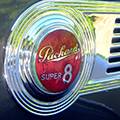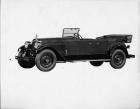|
Re: Turn Signals
|
||||
|---|---|---|---|---|
|
Home away from home
|
I recently installed this kit in my 1937 138CD and love it!. I bought the column mounted switch, but this set up will work with any momentary switch so you you can easily install a hidden switch.
The rear turn signals are great. It uses the parking lights for the front. In my case, I installed amber LED bulbs for the parking lights. At night, the headlights tend to drowned out the front turn signals, but I’m too worried about that since I can see the cars in front of me. Anyway, I’m very happy with this kit….Electro-Tech turn signals
Posted on: 9/3 15:27
|
|||
|
||||
|
Re: Turn Signals
|
||||
|---|---|---|---|---|
|
Home away from home

|
On my ‘40 160, I drilled a hole for a socket I had left over after installing a new harness. The retro looking control switch was chrome with a red knob. I robbed the plastic part of a broken door handle to replace that knob and painted the unit taupe to fit in. The parking lights on our cars have a double filament, so just extend the second unused wire from the parking lights to the control switch. I’m pretty sure the kit came with a flasher. You need a 6v one. Yes I used LEDs, but originals work fine. In either case, grounding is critical: new sockets, the band holding the control switch.
Posted on: 9/3 16:16
|
|||
|
||||
|
Re: Turn Signals
|
||||
|---|---|---|---|---|
|
Home away from home

|
Many thanks. Looking it over now.
Posted on: 9/3 18:59
|
|||
|
Steve in Indiana
1940 Super Eight 160 Sedan 1949 Deluxe Eight Sedan 1955 400 Hardtop 1956 400 Hardtop |
||||
|
||||
|
Re: Turn Signals
|
||||
|---|---|---|---|---|
|
Home away from home
|
Your 1940 should already be wired with dual element bulbs so no need to use add-on lights. When I added them to my 1940, it was a simple job and it even had a self-cancelling switch that used a rubber roller against the steering wheel hub. Not sure if that type is still available but look around and see when you can find. Either way, you’ll have to add wires as the brighter element for the parking lights terminates at the terminal block on the inner fenders and another will be needed for one of the taillights. I did it as a teenager so clearly not that difficult!
Posted on: 9/4 11:14
|
|||
|
||||
|
Re: Turn Signals
|
||||
|---|---|---|---|---|
|
Home away from home

|
Yes, Don, the 1940 has double filament bulbs, but the rear ones are dedicated to the tail lights and stoplights, so a new socket&bulb will be needed.for the blinkers.
Posted on: 9/4 18:24
|
|||
|
||||
|
Re: Turn Signals
|
||||
|---|---|---|---|---|
|
Forum Ambassador
|
Quote:
This is true on the original Packard factory turn signal circuits and on some of the earlier prewar aftermarket systems. Packard units thru 48 fall into this category and typically had 3 wires connecting the column switch with the flasher located under the dash where all the additional wire to bulb connections were made. The early aftermarkets usually had the flasher and indicator bulb in the control unit housing on the steering column and typically had 5 wires exiting the controller -- 1 power and 4 more to feed each outside bulb. If the flasher was remote then more wires depending on flasher type. Except for the front parking light bulbs which often had the spare unused filament this system was completely independent of factory wiring and needed its own bulbs to be added in the rear. With the 49 23rd series models Packard went to the more modern system which other mfgs and some of the better aftermarket units were already using. This system is basically what is still being used today and brought the brake light wire from the brake switch into into the control switch. With the control switch being able to separate and independently power the bulbs in various combinations, the turn signal function was able to have the rear bulbs share the already present brake filament with the turn signals. Aftermarket systems of this type typically had at least 7 wires exiting the control switch. If it had hazard light capability, a remote flasher unit, or some other functions built in then there was usually more wires --some having 9 or even as many as 13. Because there is only 1 wire in the 40 coming out of the brake light switch which directly feeds both brake lights that are wired in parallel, I believe the ElectroTech unit is going to need that existing wire coming from the brake switch to be identified and re routed to their control module. The rest of the original wire can then continue on to one of the rear bulbs. If the 40 loom is routed like later models the inline connector connecting to both bulbs is probably on the left side near the tail light. The brake wire in the cross over loom which has two or three wires going over to the right side bulb will need to be identified and disconnected. An additional wire coming from the control module will most likely need to be installed and connected into the brake crossover wire to power the right side bulb.
Posted on: 9/4 21:25
|
|||
|
Howard
|
||||
|
||||
|
Re: Turn Signals
|
||||
|---|---|---|---|---|
|
Home away from home
|
Quote:
Yes, Don, the 1940 has double filament bulbs, but the rear ones are dedicated to the tail lights and stoplights, so a new socket&bulb will be needed.for the blinkers. Absolutely no need for another socket but it will require an extra wire ruin to the rear. The brake lights use the same filaments as the turn signals and even my ‘50s Packards and ‘60s cars were done the same way from the factory. The turn signal switch interrupts one of the brake lights and makes it flash and it will return to normal brake light operation once the signal is off but you need to use the proper switch for that to happen. Not a great photo but you can just make it out (this was my former 1940 110 as it appeared on Facebook Marketplace recently)  An even worse cropped version 
Posted on: 9/4 21:31
|
|||
|
||||
|
Re: Turn Signals
|
||||
|---|---|---|---|---|
|
Webmaster
|
I've done this conversion on a '37. Just like modern cars, the brake lights double as the turn signal lights. So no additional sockets are needed.
Currently, there is only one brake light wire running from the dash down the left (driver's) side of the car back just before the subharness for the left taillight. At that junction, it also splits off to control the right taillight. You would have to run another wire to the back, which is connected to the right taillight brake light only, and separate the shared connection between the left and right brake lights. Both the original left wire and the new right wire then get connected to the column-mounted turn signal switch you are going to add. Then, with the turn signal switch wired in per its instructions, the rear brake lights should operate just like a modern car that does not have separate turn signal bulbs. If you hit the brakes, both brake lights come on. If you signal left, the left brake light will blink, and the right brake light will remain off. If you signal right, the right brake light will blink, and the left brake light will remain off. If you are signaling right and also press the brake pedal, then the right brake light will blink, and the left one will come on solid. If you are signaling left and also press the brake pedal, then the left brake light will blink, and the right one will come on solid. The turn signal switch takes care of all this magic once the extra wire is run, and the brake lights are separated into their own circuits.
Posted on: 9/5 9:12
|
|||
|
-BigKev
1954 Packard Clipper Deluxe Touring Sedan -> Registry | Project Blog 1937 Packard 115-C Convertible Coupe -> Registry | Project Blog |
||||
|
||||
|
Re: Turn Signals
|
||||
|---|---|---|---|---|
|
Home away from home
|
As I mentioned before (and provided a link), I am really happy with the turn signals kit I installed. It also has the benefit of using either a column mounted switch or any other momentary switch that can be discretely mounted wherever you want. And, If I wanted to remove the kit and restore everything to original, it would only take about five minutes.
Posted on: 9/5 9:45
|
|||
|
||||

 IMG_0194.jpeg (2,722.31 KB)
IMG_0194.jpeg (2,722.31 KB)








